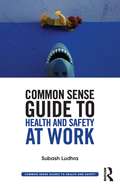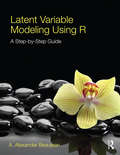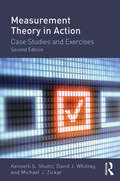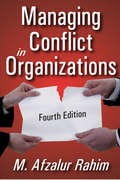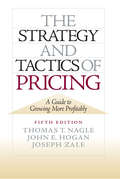- Table View
- List View
Introduction to Health and Safety at Work: for the NEBOSH National General Certificate in Occupational Health and Safety
by Phil Hughes Ed FerrettIntroduction to Health and Safety at Work covers the fundamentals of occupational safety and health for the thousands of students who complete the NEBOSH National General Certificate in Occupational Health and Safety each year. Fully revised in alignment with the April 2015 syllabus, this sixth edition provides students with all they need to tackle the course with confidence. The highly illustrated content covers all of the essential elements of health and safety management, the legal framework, risk assessment and control standards and also includes checklists, report forms and record sheets to supplement learning. Aligned to the NEBOSH National General Certificate in Occupational Health and Safety Practice questions and answers to test knowledge and increase understanding Complete with a companion website containing extra resources for tutors and students at www.routledge.com/cw/hughes Written by renowned authors, the Introduction to Health and Safety at Work is also a handy reference for managers and directors dealing with the day-to-day issues of health and safety and is of great value to those studying for level 3 N/SVQ and the NEBOSH National Diploma.
Common Sense Guide to Health & Safety at Work
by Subash LudhraAn essential and short guide for employees who need to know more about health and safety in the workplace without wanting to spend hours reading dozens of different documents. Whether it’s for use alongside a training course or simply to brush up on your knowledge, it’s perfect for equipping you with the principles of health and safety. Friendly and accessible, this Common Sense Guide covers all the main aspects of health and safety in manageable chapters to provide you with the knowledge and understanding you need to look after yourself and others in the workplace. Suitable for the non-health and safety professional Includes questions at the end of each module to consolidate your health and safety knowledge Certificate offered to those who complete the exam at the end of the book and return to be marked externally.
Common Sense Guide to Health & Safety at Work
by Subash LudhraAn essential and short guide for employees who need to know more about health and safety in the workplace without wanting to spend hours reading dozens of different documents. Whether it’s for use alongside a training course or simply to brush up on your knowledge, it’s perfect for equipping you with the principles of health and safety. Friendly and accessible, this Common Sense Guide covers all the main aspects of health and safety in manageable chapters to provide you with the knowledge and understanding you need to look after yourself and others in the workplace. Suitable for the non-health and safety professional Includes questions at the end of each module to consolidate your health and safety knowledge Certificate offered to those who complete the exam at the end of the book and return to be marked externally.
Principles of Horticulture: Level 3
by Charles Adams Mike Early Jane Brook Katherine BamfordThis colourful guide will explain the fundamentals of growing plants, whether you are taking a Level 3 RHS, City and Guilds or Edexcel course, are a grower or gardener in the industry, or are just a keen amateur. Written in a clear and accessible style, this book covers the principles that underpin plant production, the use of growing media and crop protection, but with reference also to the same practices in the garden or allotment. With highlighted definitions, key points, and illustrated in full colour, this book will be a useful companion as you progress in the study and practice of horticulture. Complete with a companion website which includes extended horticultural information, questions and exercises to test your knowledge, syllabus cross-referencing and downloadable tutor and student support materials.
Corporate Social Irresponsibility
by Paula AlexanderCorporate Social Irresponsibility focuses on ethical failures in order to relate corporate responsibility to business ethics, corporate governance, and organization effectiveness. The book advocates a strategic approach to CSR – ethical management cannot, and should not, be divorced from effective management. Corporate social responsibility has transitioned from oxymoron into a defining challenge of the twenty first century. Taking the recent financial crisis as a starting point, Alexander examines the underlying ethical and legal crises these events expose in the business world. The problems that have come to light go beyond issues of firm financial performance into the integrity of the manufacturing and marketing processes, and relations with consumers. As such, the book presents a model that resolves the apparent conflict between maximizing shareholder value, and meeting the interests of other firm stakeholders. Alexander presents a balanced view, contrasting her model with alternative approaches. The book also covers the impact of globalization on management, the ethics of outsourcing, the limits of regulation, as well as poverty alleviation and social entrepreneurship. Blending a comprehensive theoretical framework with a broad range of cases, this book covers the latest major changes in US legislation, as well as recent corporate scandals making it a valuable accompaniment to any course in CSR, business ethics, or business, government and society.
Finance for Small and Entrepreneurial Business (Routledge Masters in Entrepreneurship)
by Richard RobertsThe financial environment of small and entrepreneurial firms is changing rapidly and is a topic where significant disagreement remains amongst researchers and policy advisers. This concise textbook provides a comprehensive overview of the current and projected trends in this market for the benefit of students of entrepreneurship at an advanced level. Written by an expert on SME finance, it provides a straightforward review of the external funding choices faced by small business owners, drawing on a range of new data sources which have emerged in recent years, along with a range of case studies. In addition, it includes an analysis of longer term trends and the role of the changing phases of the business cycle to equip readers to better understand the wider market environment both now and in the future. Roberts provides students of entrepreneurship with everything they need to know to excel in understanding the financial environment and its effect on small business.
Latent Variable Modeling Using R: A Step-by-Step Guide
by A. Alexander BeaujeanThis step-by-step guide is written for R and latent variable model (LVM) novices. Utilizing a path model approach and focusing on the lavaan package, this book is designed to help readers quickly understand LVMs and their analysis in R. The author reviews the reasoning behind the syntax selected and provides examples that demonstrate how to analyze data for a variety of LVMs.? Featuring examples applicable to psychology, education, business, and other social and health sciences, minimal text is devoted to theoretical underpinnings. The material is presented without?the use of matrix algebra. As a whole the book prepares readers to write about and interpret LVM results they obtain in R. Each chapter features background information, boldfaced key? terms defined in the glossary, detailed interpretations of R output, descriptions of how to write the analysis of results for publication, a summary, R based practice exercises (with solutions included in the back of the book), and references and related readings. Margin notes help readers better understand LVMs and write their own R syntax. Examples using data from published work across a variety of disciplines demonstrate how to use R syntax for analyzing and interpreting results. R functions, syntax, and the corresponding results appear in gray boxes to help readers quickly locate this material. A unique index helps readers quickly locate R?functions, packages, and datasets. The book and accompanying website at http://blogs.baylor.edu/rlatentvariable/ provides all of the data for the book’s examples and exercises as well as R syntax so readers can replicate the analyses. The book reviews how to enter the data into R, specify the LVMs, and obtain and interpret the estimated parameter values. The book opens with the fundamentals of using R including how to download the program, use functions, and enter and manipulate data. Chapters 2 and 3 introduce and then extend path models to include latent variables. Chapter 4 shows readers how to analyze a latent variable model with data from more than one group, while Chapter 5 shows how to analyze a latent variable model with data from more than one time period. Chapter 6 demonstrates the analysis of dichotomous variables, while Chapter 7 demonstrates how to analyze LVMs with missing data. Chapter 8 focuses on sample size determination using Monte Carlo methods, which can be used with a wide range of statistical models and account for missing data. The final chapter examines hierarchical LVMs, demonstrating both higher-order and bi-factor approaches. The book concludes with three Appendices: a review of common measures of model fit including their formulae and interpretation; syntax for other R latent variable models packages; and solutions for each chapter’s exercises. Intended as a supplementary text for graduate and/or advanced undergraduate courses on latent variable modeling, factor analysis, structural equation modeling, item response theory, measurement, or multivariate statistics taught in psychology, education, human development, business, economics, and social and health sciences, this book also appeals to researchers in these fields. Prerequisites include familiarity with basic statistical concepts, but knowledge of R is not assumed.
Latent Variable Modeling Using R: A Step-by-Step Guide
by A. Alexander BeaujeanThis step-by-step guide is written for R and latent variable model (LVM) novices. Utilizing a path model approach and focusing on the lavaan package, this book is designed to help readers quickly understand LVMs and their analysis in R. The author reviews the reasoning behind the syntax selected and provides examples that demonstrate how to analyze data for a variety of LVMs.? Featuring examples applicable to psychology, education, business, and other social and health sciences, minimal text is devoted to theoretical underpinnings. The material is presented without?the use of matrix algebra. As a whole the book prepares readers to write about and interpret LVM results they obtain in R. Each chapter features background information, boldfaced key? terms defined in the glossary, detailed interpretations of R output, descriptions of how to write the analysis of results for publication, a summary, R based practice exercises (with solutions included in the back of the book), and references and related readings. Margin notes help readers better understand LVMs and write their own R syntax. Examples using data from published work across a variety of disciplines demonstrate how to use R syntax for analyzing and interpreting results. R functions, syntax, and the corresponding results appear in gray boxes to help readers quickly locate this material. A unique index helps readers quickly locate R?functions, packages, and datasets. The book and accompanying website at http://blogs.baylor.edu/rlatentvariable/ provides all of the data for the book’s examples and exercises as well as R syntax so readers can replicate the analyses. The book reviews how to enter the data into R, specify the LVMs, and obtain and interpret the estimated parameter values. The book opens with the fundamentals of using R including how to download the program, use functions, and enter and manipulate data. Chapters 2 and 3 introduce and then extend path models to include latent variables. Chapter 4 shows readers how to analyze a latent variable model with data from more than one group, while Chapter 5 shows how to analyze a latent variable model with data from more than one time period. Chapter 6 demonstrates the analysis of dichotomous variables, while Chapter 7 demonstrates how to analyze LVMs with missing data. Chapter 8 focuses on sample size determination using Monte Carlo methods, which can be used with a wide range of statistical models and account for missing data. The final chapter examines hierarchical LVMs, demonstrating both higher-order and bi-factor approaches. The book concludes with three Appendices: a review of common measures of model fit including their formulae and interpretation; syntax for other R latent variable models packages; and solutions for each chapter’s exercises. Intended as a supplementary text for graduate and/or advanced undergraduate courses on latent variable modeling, factor analysis, structural equation modeling, item response theory, measurement, or multivariate statistics taught in psychology, education, human development, business, economics, and social and health sciences, this book also appeals to researchers in these fields. Prerequisites include familiarity with basic statistical concepts, but knowledge of R is not assumed.
Measurement Theory in Action: Case Studies and Exercises, Second Edition
by Kenneth S. Shultz David J. Whitney Michael J. ZickarThis book helps readers apply testing and measurement theories. Featuring 22 self-standing modules, instructors can pick and choose the ones that are most appropriate for their course. Each module features an overview of a measurement issue and a step-by-step application of that theory. Best practices provide recommendations for ensuring the appropriate application of the theory. Practical questions help students assess their understanding of the topic while the examples allow them to apply the material using real data. Two cases in each module depict typical dilemmas faced when applying measurement theory followed by Questions to Ponder to encourage critical examination of the issues noted in the cases. Each module contains exercises some of which require no computer access while others involve the use of SPSS to solve the problem. The book’s website houses the accompanying data sets and more. The book also features suggested readings, a glossary of the key terms, and a continuing exercise that incorporates many of the steps in the development of a measure of typical performance. Updated throughout to reflect recent changes in the field, the new edition also features: --A new co-author, Michael Zickar, who updated the advanced topics and added the new module on generalizability theory (Module 22). -Expanded coverage of reliability (Modules 5 & 6) and exploratory and confirmatory factor analysis (Modules 18 & 19) to help readers interpret results presented in journal articles. -Expanded Web Resources, Instructors will now find: suggested answers to the book’s questions and exercises; detailed worked solutions to the exercises; and PowerPoint slides. Students and instructors can access the SPSS data sets; additional exercises; the glossary; and website references that are helpful in understanding psychometric concepts. Part 1 provides an introduction to measurement theory and specs for scaling and testing and a review of statistics. Part 2 then progresses through practical issues related to text reliability, validation, meta-analysis and bias. Part 3 reviews practical issues related to text construction such as the development of measures of maximal performance, CTT item analysis, test scoring, developing measures of typical performance, and issues related to response styles and guessing. The book concludes with advanced topics such as multiple regression, exploratory and confirmatory factor analysis, item response theory (IRT), IRT applications including computer adaptive testing and differential item functioning, and generalizability theory. Ideal as a text for any psychometrics, testing and measurement, or multivariate statistics course taught in psychology, education, marketing and management, professional researchers in need of a quick refresher on applying measurement theory will also find this an invaluable reference.
Measurement Theory in Action: Case Studies and Exercises, Second Edition
by Kenneth S. Shultz David J. Whitney Michael J. ZickarThis book helps readers apply testing and measurement theories. Featuring 22 self-standing modules, instructors can pick and choose the ones that are most appropriate for their course. Each module features an overview of a measurement issue and a step-by-step application of that theory. Best practices provide recommendations for ensuring the appropriate application of the theory. Practical questions help students assess their understanding of the topic while the examples allow them to apply the material using real data. Two cases in each module depict typical dilemmas faced when applying measurement theory followed by Questions to Ponder to encourage critical examination of the issues noted in the cases. Each module contains exercises some of which require no computer access while others involve the use of SPSS to solve the problem. The book’s website houses the accompanying data sets and more. The book also features suggested readings, a glossary of the key terms, and a continuing exercise that incorporates many of the steps in the development of a measure of typical performance. Updated throughout to reflect recent changes in the field, the new edition also features: --A new co-author, Michael Zickar, who updated the advanced topics and added the new module on generalizability theory (Module 22). -Expanded coverage of reliability (Modules 5 & 6) and exploratory and confirmatory factor analysis (Modules 18 & 19) to help readers interpret results presented in journal articles. -Expanded Web Resources, Instructors will now find: suggested answers to the book’s questions and exercises; detailed worked solutions to the exercises; and PowerPoint slides. Students and instructors can access the SPSS data sets; additional exercises; the glossary; and website references that are helpful in understanding psychometric concepts. Part 1 provides an introduction to measurement theory and specs for scaling and testing and a review of statistics. Part 2 then progresses through practical issues related to text reliability, validation, meta-analysis and bias. Part 3 reviews practical issues related to text construction such as the development of measures of maximal performance, CTT item analysis, test scoring, developing measures of typical performance, and issues related to response styles and guessing. The book concludes with advanced topics such as multiple regression, exploratory and confirmatory factor analysis, item response theory (IRT), IRT applications including computer adaptive testing and differential item functioning, and generalizability theory. Ideal as a text for any psychometrics, testing and measurement, or multivariate statistics course taught in psychology, education, marketing and management, professional researchers in need of a quick refresher on applying measurement theory will also find this an invaluable reference.
Leadership: A Critical Introduction
by Elesa ZehndorferLeadership is crucial to the success of any organisation. But how can one seek to most effectively develop the leadership ability of both themselves, and others? How should one define leadership? Are great leaders born or made? This text addresses such fundamental questions via a comprehensive and critical approach to the discussion of key leadership theories. The text encourages the reader to consider the role of both follower and leader in the leadership process, and to recognise the emergence of both effective, and destructive, leadership.? Each chapter features 'Expert Insights' on leadership, written by leaders in their respective fields. These insights offer the reader a valuable real-world perspective of leadership that enriches the abstract theory covered in each chapter. The provision of case studies, examples and supplementary online material provide the effective delivery of both undergraduate and postgraduate lectures and workshops, and self-guided study. A concluding chapter that focuses on the development of one’s self-leadership ultimately facilitates a comprehensive introduction to what is at once a seductive, complex, transformative and alluring topic.
Leadership: A Critical Introduction
by Elesa ZehndorferLeadership is crucial to the success of any organisation. But how can one seek to most effectively develop the leadership ability of both themselves, and others? How should one define leadership? Are great leaders born or made? This text addresses such fundamental questions via a comprehensive and critical approach to the discussion of key leadership theories. The text encourages the reader to consider the role of both follower and leader in the leadership process, and to recognise the emergence of both effective, and destructive, leadership.? Each chapter features 'Expert Insights' on leadership, written by leaders in their respective fields. These insights offer the reader a valuable real-world perspective of leadership that enriches the abstract theory covered in each chapter. The provision of case studies, examples and supplementary online material provide the effective delivery of both undergraduate and postgraduate lectures and workshops, and self-guided study. A concluding chapter that focuses on the development of one’s self-leadership ultimately facilitates a comprehensive introduction to what is at once a seductive, complex, transformative and alluring topic.
Managing Conflict in Organizations
by M. Afzalur RahimAfter much debate by business professionals, organizational conflict is now considered normal and legitimate; it may even be a positive indicator of effective organizational management. Within certain limits, conflict can be essential to productivity. This book contributes to the investigation of organizational conflict by analyzing its origins, forms, benefits, and consequences.Conflict has benefits: it may lead to solutions to problems, creativity, and innovation. In contrast, little or no conflict in organizations may lead to stagnation, poor decisions, and ineffectiveness. Managing Conflict in Organizations is a vigorous analysis of the rational application of conflict theory in organizations.Conflict is inevitable among humans. It is a natural outcome of human interaction that begins when two or more social entities engage one another while striving to attain their own objectives. Relationships among people or organizations become incompatible or inconsistent when two or more of them desire a similar resource that is in short supply; when they do not share behavioral preferences regarding their joint action; or when they have different attitudes, values, beliefs, and skills. This book examines these root causes of organizational conflict and offers constructive perspectives on its consequences.
Managing Conflict in Organizations
by M. Afzalur RahimAfter much debate by business professionals, organizational conflict is now considered normal and legitimate; it may even be a positive indicator of effective organizational management. Within certain limits, conflict can be essential to productivity. This book contributes to the investigation of organizational conflict by analyzing its origins, forms, benefits, and consequences.Conflict has benefits: it may lead to solutions to problems, creativity, and innovation. In contrast, little or no conflict in organizations may lead to stagnation, poor decisions, and ineffectiveness. Managing Conflict in Organizations is a vigorous analysis of the rational application of conflict theory in organizations.Conflict is inevitable among humans. It is a natural outcome of human interaction that begins when two or more social entities engage one another while striving to attain their own objectives. Relationships among people or organizations become incompatible or inconsistent when two or more of them desire a similar resource that is in short supply; when they do not share behavioral preferences regarding their joint action; or when they have different attitudes, values, beliefs, and skills. This book examines these root causes of organizational conflict and offers constructive perspectives on its consequences.
Understanding Company Law
by Alastair HudsonUnderstanding Company Law is a lively introduction to the key principles of the Companies Act 2006 and modern company law. It takes a unique approach to the subject, which also encompasses the important and growing fields of securities regulation, corporate governance and corporate social responsibility. This book covers all of the key topics that a student reader will encounter in any company law course. The discussion presents the key principles simply, before guiding the reader through the more complex issues that are often the focus of examinations in this subject. It also offers pathways into further reading, while injecting enjoyment back into the topic. In Understanding Company Law, Professor Hudson provides a straightforward guide to the law, while providing context, detailed analyses of the leading cases, and no little humour. The second edition covers key recent changes and developments in company law, both case law and statutory, including: two recent Supreme Court decisions on piercing the corporate veil, VTB Capital plc v Nutritek International Corp and others and Prest v Petrodel Resources Limited & Others, and an analysis of the Conservative government’s Green Paper on Corporate Governance. Online supportVisit the author’s website at www.alastairhudson.com to find podcasts of specially recorded lectures covering the basic principles and an audiobook version of this text.
Stone Age Economics (Routledge Classics)
by Marshall SahlinsSince its first publication over forty years ago Marshall Sahlins's Stone Age Economics has established itself as a classic of modern anthropology and arguably one of the founding works of anthropological economics. Ambitiously tackling the nature of economic life and how to study it comparatively, Sahlins radically revises traditional views of the hunter-gatherer and so-called primitive societies, revealing them to be the original "affluent society." Sahlins examines notions of production, distribution and exchange in early communities and examines the link between economics and cultural and social factors. A radical study of tribal economies, domestic production for livelihood, and of the submission of domestic production to the material and political demands of society at large, Stone Age Economics regards the economy as a category of culture rather than behaviour, in a class with politics and religion rather than rationality or prudence. Sahlins concludes, controversially, that the experiences of those living in subsistence economies may actually have been better, healthier and more fulfilled than the millions enjoying the affluence and luxury afforded by the economics of modern industrialisation and agriculture. This Routledge Classics edition includes a new foreword by David Graeber, London School of Economics.
Building Brands in Asia: From the Inside Out
by Tim Andrews Wilson ChewIn a global business environment characterized by volatility and change, the formation of enduring relationships with consumers is paramount, but also notoriously difficult. Developing a unique brand personality is increasingly recognized as a key method to achieving the goal of customer loyalty. Focusing on the creation, development and management of brands in the world’s most dynamic, diverse and challenging business environment, Building Brands in Asia challenges the assumption that the continuing success of global brands in Asia is a given. The first part examines the challenge multinational corporations face in balancing brand consistency with local effectiveness. In the second part, attention shifts to Asian company brands, where the focus on branding has been relatively muted until now. Through a variety of sector and country contexts – from facilities management to football clubs, places to pop bands, home appliances to home weaving - we narrate simply and clearly the value, meaning, auditing, aligning, extending and architecture of brands from the likes of Haier, Ah Yee Taung, Axis Bank, OCS, Caltex, Manchester United and Thai Airways in markets as diverse as Japan, Laos, Korea and Singapore. Replete with anecdotes, interviews and case studies, Andrews and Chew provide an insightful, detailed and timely examination for all those interested in today’s primary corporate preoccupation set in the world’s most exciting marketplace.
Building Brands in Asia: From the Inside Out
by Tim Andrews Wilson ChewIn a global business environment characterized by volatility and change, the formation of enduring relationships with consumers is paramount, but also notoriously difficult. Developing a unique brand personality is increasingly recognized as a key method to achieving the goal of customer loyalty. Focusing on the creation, development and management of brands in the world’s most dynamic, diverse and challenging business environment, Building Brands in Asia challenges the assumption that the continuing success of global brands in Asia is a given. The first part examines the challenge multinational corporations face in balancing brand consistency with local effectiveness. In the second part, attention shifts to Asian company brands, where the focus on branding has been relatively muted until now. Through a variety of sector and country contexts – from facilities management to football clubs, places to pop bands, home appliances to home weaving - we narrate simply and clearly the value, meaning, auditing, aligning, extending and architecture of brands from the likes of Haier, Ah Yee Taung, Axis Bank, OCS, Caltex, Manchester United and Thai Airways in markets as diverse as Japan, Laos, Korea and Singapore. Replete with anecdotes, interviews and case studies, Andrews and Chew provide an insightful, detailed and timely examination for all those interested in today’s primary corporate preoccupation set in the world’s most exciting marketplace.
Entrepreneurial Marketing: An Effectual Approach
by Edwin J. NijssenHow do you sell an innovative product to a market that does not yet exist? Entrepreneurial businesses often create products and services based on radically new technology that have the power to change the marketplace. Existing market research data will be largely irrelevant in these cases, making sales and marketing of innovative new products especially challenging to entrepreneurs. Entrepreneurial Marketing focuses on this challenge. Classic core marketing concepts, such as segmentation, positioning and the marketing mix undergo an ‘extreme makeover’ in the context of innovative products hitting the market. Edwin J. Nijssen stresses principles of affordable loss, experimentation and adjustment for emerging opportunities, as well as cooperation with first customers. Containing many marketing examples of successful and cutting edge innovations (including links to websites and videos on the Internet), useful lists of key issues and instructions on how to make a one-page marketing plan, Entrepreneurial Marketing: An Effectual Approach provides a vital guide to successfully developing customer demand and a market for innovative new products. This second edition has been thoroughly expanded with: a one-page marketing plan which now focuses on the three entrepreneurial challenges that can be easily adapted; coverage of the customer development process; and updated references and new examples. This book provides students and entrepreneurs with the fundamental tools to succeed in marketing.
Entrepreneurial Marketing: An Effectual Approach
by Edwin J. NijssenHow do you sell an innovative product to a market that does not yet exist? Entrepreneurial businesses often create products and services based on radically new technology that have the power to change the marketplace. Existing market research data will be largely irrelevant in these cases, making sales and marketing of innovative new products especially challenging to entrepreneurs. Entrepreneurial Marketing focuses on this challenge. Classic core marketing concepts, such as segmentation, positioning and the marketing mix undergo an ‘extreme makeover’ in the context of innovative products hitting the market. Edwin J. Nijssen stresses principles of affordable loss, experimentation and adjustment for emerging opportunities, as well as cooperation with first customers. Containing many marketing examples of successful and cutting edge innovations (including links to websites and videos on the Internet), useful lists of key issues and instructions on how to make a one-page marketing plan, Entrepreneurial Marketing: An Effectual Approach provides a vital guide to successfully developing customer demand and a market for innovative new products. This second edition has been thoroughly expanded with: a one-page marketing plan which now focuses on the three entrepreneurial challenges that can be easily adapted; coverage of the customer development process; and updated references and new examples. This book provides students and entrepreneurs with the fundamental tools to succeed in marketing.
The Practical Guide to Organising Events (The Practical Guide to Events and Hotel Management Series)
by Philip BernersThe Practical Guide to Organising Events is a short, accessible and practical guide on how to successfully plan and organise a variety of event types in a wide range of contexts. The core sections of the text are logically structured around the key stages of event management – pre-event, on-site and post-event – offering essential practical insight and guidance throughout the whole process. Topics covered include proposal writing, budget, funding and sponsorship, health and safety, security and evaluation. This is a fundamental resource for all events management students running and organising an event as part of their degree programme. It is also a book for anybody who just happens to be tasked with organising an event such as an office party, a social networking event, Christmas party or family wedding. Based on experience, using real-life case studies and anecdotal examples, The Practical Guide to Organising Events ultimately makes the business of events management appealing, understandable and achievable.
The Management of a Student Research Project
by John Peters John A SharpThe third edition of this popular book has been extensively revised to reflect the changes that have affected student research in higher education in recent years. The ability to carry out research successfully has come to be seen as a 'key transferable skill' required of all higher education students - and The Management of a Student Research Project addresses directly the skill element of this. Furthermore the research process, at all levels, is far more systematized than in the past. The single largest change since the second edition came out in 1996 has been the impact of the World Wide Web on student research. The third edition has been thoroughly rewritten and developed in response to this. In particular, Chapter 4, 'Literature Searching', has been structured around a sample online search. Throughout, the comments and thoughts of readers of previous editions have been taken into account in framing this third edition. Its aims remain the same - to provide a clear, comprehensive and useful guide to students undertaking research projects in order to improve their chances of a successful outcome.
The Global Information Society
by William J. MartinToday, information and the technologies that store and disseminate it are producing deep-rooted and widespread changes in society - changes of the same magnitude as those that occurred during the Industrial Revolution. The purpose of this book is to give a complete picture of the information society by examining in detail the social, economic, political, and cultural roles of information and information technology. This book is effectively a second edition of the author's classic The Information Society. In it, the author illustrates the major trends in and inter-relationships between information, information and communication technologies, and the global economy and society. In tracing the direction of information-based change he reveals the implications for ordinary citizens, for the quality of everyday life, for economic and social activity, and examines the prospects of nations and trading blocs. This book provides a new way of looking at society, one that is essential for understanding social and economic structures and processes in the information age.
The Strategy and Tactics of Pricing: New International Edition
by Thomas T. Nagle John Hogan Joseph ZaleFor undergraduate introduction to Market Pricing courses. A comprehensive and practical, step-by-step guide to pricing analysis and strategy development. The Strategy and Tactics of Pricing shows readers how to manage markets strategically—rather than simply calculate pricing based on product and profit—in order to improve their competitiveness and the profitability of their offers. The fifth edition contains a new chapter on price implementation and several updated examples on pricing challenges in today’s markets. Features: NEW! Show students how proper pricing can increase profitability—New Chapter on Price Implementation. A completely new chapter on implementing pricing strategy identifies the challenges involved in embedding strategic pricing principles within an organization. This chapter also describes how managers can lead a structured change process to build a more profitable commercial organization. NEW! Offer access to pricing software—Three-Month Trial of LeveragePoint Software. This edition is now available with software for creating and communicating economic value estimations systematically—from LeveragePoint Innovations Inc. While versions of this software that enable sharing require corporate contracts for access, versions for individual student and practitioner use are available without charge for three months with the purchase of The Strategy and Tactics of Pricing. NEW! Make pricing theory relative—Updated Examples of Pricing. Helping connect pricing theory to what students are familiar with, this edition includes updated examples with more topical illustrations of current pricing challenges such as: • iPhone pricing • New models for pricing music • Services pricing NEW! Present the latest information—Heavily Revised Chapters. The revised chapter on Pricing Policy provides a theoretically-grounded framework to describe specific policies for managing price changes for situations such as:-Cost-based price increases -Price reductions in a recession-Discounts The chapter on Value Creation now addresses the difference between how to consider value when it is driven by tangible monetary drivers (saving money on gas) versus the more subjective psychological drivers (doing the right thing for the environment). The chapter on Value and Price Communication has been substantially revised to describe how to communicate value in a wide variety of product and customer contexts. This chapter also demonstrates how to target communications to affect specific behaviors throughout the customer’s buying process.The chapter on Price Setting has been expanded to provide a robust process for setting prices that can be widely applied to consumer and business markets.
The Strategy and Tactics of Pricing: New International Edition
by Thomas T. Nagle John Hogan Joseph ZaleFor undergraduate introduction to Market Pricing courses. A comprehensive and practical, step-by-step guide to pricing analysis and strategy development. The Strategy and Tactics of Pricing shows readers how to manage markets strategically—rather than simply calculate pricing based on product and profit—in order to improve their competitiveness and the profitability of their offers. The fifth edition contains a new chapter on price implementation and several updated examples on pricing challenges in today’s markets. Features: NEW! Show students how proper pricing can increase profitability—New Chapter on Price Implementation. A completely new chapter on implementing pricing strategy identifies the challenges involved in embedding strategic pricing principles within an organization. This chapter also describes how managers can lead a structured change process to build a more profitable commercial organization. NEW! Offer access to pricing software—Three-Month Trial of LeveragePoint Software. This edition is now available with software for creating and communicating economic value estimations systematically—from LeveragePoint Innovations Inc. While versions of this software that enable sharing require corporate contracts for access, versions for individual student and practitioner use are available without charge for three months with the purchase of The Strategy and Tactics of Pricing. NEW! Make pricing theory relative—Updated Examples of Pricing. Helping connect pricing theory to what students are familiar with, this edition includes updated examples with more topical illustrations of current pricing challenges such as: • iPhone pricing • New models for pricing music • Services pricing NEW! Present the latest information—Heavily Revised Chapters. The revised chapter on Pricing Policy provides a theoretically-grounded framework to describe specific policies for managing price changes for situations such as:-Cost-based price increases -Price reductions in a recession-Discounts The chapter on Value Creation now addresses the difference between how to consider value when it is driven by tangible monetary drivers (saving money on gas) versus the more subjective psychological drivers (doing the right thing for the environment). The chapter on Value and Price Communication has been substantially revised to describe how to communicate value in a wide variety of product and customer contexts. This chapter also demonstrates how to target communications to affect specific behaviors throughout the customer’s buying process.The chapter on Price Setting has been expanded to provide a robust process for setting prices that can be widely applied to consumer and business markets.

